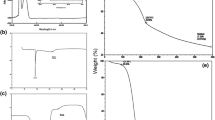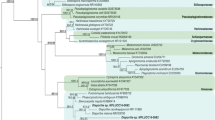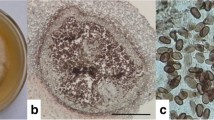Abstract
Mitrephora wangii, an ethnomedicinal plant, has been used as a natural antibiotic and immunity booster in Thailand. A total of 22 fungi were isolated from M. wangii flowers. The fungal isolates were categorized into six genera including Agrocybe, Aspergillus, Colletotrichum, Nigrospora, Puccinia and Ustilago. Most extracts exhibited antibacterial activity against at least one of the test bacteria. Aspergillus sp. MFLUCC16-0845 was identified as the most bioactive fungus. Chemical composition of Aspergillus sp. MFLUCC16-0845 investigated using gas chromatography–mass spectrometry indicated that the major antibacterial compound was β-thujaplicin. Moreover, the newly isolated Aspergillus sp. MFLUCC16-0845 could be exploited as a potential source of bioactive compounds and plant defense activators. In addition, it is the first time that strain of Aspergillus sp. isolated and cultured from M. wangii flowers could produce β-thujaplicin at high yield with strong antimicrobial spectrum, which may lead to wide utilization in producing cosmetics and clinical products.

Similar content being viewed by others
References
Adams RP (2007) Identification of essential oil components by gas chromatography/mass spectroscopy, 4th edn. Allured Publishing Corporation, Illinois
Aly AH, Debbab A, Kjer J, Proksch P (2010) Fungal endophytes from higher plants: a prolific source of phytochemicals and other bioactive natural products. Fungal Divers 41:1–16
Araújo WL, Marcon J, Maccheroni W, van Elsas JD, van Vuurde JW, Azevedo JL (2002) Diversity of endophytic bacterial populations and their interaction with Xylella fastidiosa in citrus plants. Appl Environ Microbiol 68:4906–4914
Arima Y, Nakai Y, Hayakawa R, Nishino T (2003) Antibacterial effect of β-thujaplicin on staphylococci isolated from atopic dermatitis: relationship between changes in the number of viable bacterial cells and clinical improvement in an eczematous lesion of atopic dermatitis. J Antimicrob Chemother 51:113–122
Atiphasaworn P, Monggoot S, Gentekaki E, Brooks S, Pripdeevech P (2017) Antibacterial and antioxidant constituents of extracts of endophytic fungi isolated from Ocimum basilicum var. thyrsiflora leaves. Curr Opin Microbiol 74:1185–1193
Azevedo JL, Maccheroni JW, Pereira JO, de Araújo WL (2000) Endophytic microorganisms: a review on insect control and recent advances on tropical plants. Electron J Biotechnol 3:40–65
Barnett HL, Hunter BB (1998) Illustrated genera of imperfect fungi. Illustrated genera of imperfect fungi, 3rd edn. APS Press, Minnesota
Barrero AF, del Moral JFQ, Lara A, Herrador MM (2005) Antimicrobial activity of sesquiterpenes from the essential oil of Juniperus thurifera wood. Planta Med 71:67–71
Berdy J (2005) Bioactive microbial metabolites. J Antibiot 58:1–26
Cakir A, Kordali S, Zengin H, Izumi S, Hirata T (2004) Composition and antifungal activity of essential oils isolated from Hypericum hyssopifolium and H. heterophyllum. Flavour Fragr J 19:62–68
Capella-Gutiérrez S, Silla-Martínez JM, Gabaldón T (2009) trimAl: a tool for automated alignment trimming in large-scale phylogenetic analyses. Bioinformatics 25:1972–1973
Cha JD, Jeong MR, Jeong SI, Moon SE, Kim JY, Kil BS, Song YH (2005) Chemical composition and antimicrobial activity of the essential oils of Artemisia scoparia and A. capillaris. Planta Med 71:186–190
Cristani M, D’Arrigo M, Mandalari G, Castelli F, Sarpietro MG, Micieli D, Trombetta D (2007) Interaction of four monoterpenes contained in essential oils with model membranes: implications for their antibacterial activity. J Agric Food Chem 55:6300–6308
Farshori NN, Banday MR, Ahmad A, Khan AU, Rauf A (2011) 7-Hydroxy-coumarin derivatives: synthesis, characterization and preliminary antimicrobial activities. Med Chem Res 20:535–541
Ge H, Kong X, Shi L, Hou L, Liu Z, Li P (2009) Gamma-linolenic acid induces apoptosis and lipid peroxidation in human chronic myelogenous leukemia K562 cells. Cell Biol Int Rep 33:402–410
Geiser DM (2009) Sexual structures in Aspergillus: morphology, importance and genomics. Med Mycol 47:21–26
Gunatilaka AL (2006) Natural products from plant-associated microorganisms: distribution, structural diversity, bioactivity, and implications of their occurrence. J Nat Prod 69:509–526
Inoue Y, Shiraishi A, Hada T, Hirose K, Hamashima H, Shimada J (2004) The antibacterial effects of terpene alcohols on Staphylococcus aureus and their mode of action. FEMS Microbiol Lett 237:325–331
Katoh K, Toh H (2010) Parallelization of the MAFFT multiple sequence alignment program. Bioinformatics 26:1899–1900
Kurose D, Furuya N, Tsuchiya K, Tsushima S, Evans H (2012) Endophytic fungi associated with Fallopia japonica (Polygonaceae) in Japan and their interactions with Puccinia polygoni-amphibii var. tovariae, a candidate for classical biological control. Fungal Biol 116:785–791
Kusari S, Lamshöft M, Spiteller M (2009) Aspergillus fumigatus Fresenius, an endophytic fungus from Juniperus communis L. Horstmann as a novel source of the anticancer pro-drug deoxypodophyllotoxin. J Appl Microbiol 107:1019–1030
Li XJ, Zhang Q, Zhang AL, Gao JM (2012) Metabolites from Aspergillus fumigatus, an endophytic fungus associated with Melia azedarach, and their antifungal, antifeedant, and toxic activities. J Agric Food Chem 60:3424–3431
Lu H, Zou WX, Meng JC, Hu J, Tan RX (2000) New bioactive metabolites produced by Colletotrichum sp., an endophytic fungus in Artemisia annua. Plant Sci 151:67–173
Machumi F, Samoylenko V, Yenesew A, Derese S, Midiwo JO, Wiggers FT, Muhammad I (2010) Antimicrobial and antiparasitic abietane diterpenoids from the roots of Clerodendrum eriophyllum. Nat Prod Commun 5:853–858
Márquez SS, Bills GF, Zabalgogeazcoa I (2007) The endophytic mycobiota of the grass Dactylis glomerata. Fungal Divers 27:171–195
Miller MA, Pfeiffer W, Schwartz T (2010) Creating the CIPRES Science Gateway for inference of large phylogenetic trees. In: Proceedings of the gateway computing environments workshop (GCE), 14 November, Ieee, Louisiana, pp 1–8
Owen NL, Hundley N (2004) Endophytes—the chemical synthesizers inside plants. Sci Prog 87:79–99
Petrini O, Sieber TN, Toti L, Viret O (1993) Ecology, metabolite production, and substrate utilization in endophytic fungi. Nat Toxins 1:185–196
Rai M, Rathod D, Agarkar G, Dar M, Brestic M, Pastore GM, Junior MRM (2014) Fungal growth promotor endophytes: a pragmatic approach towards sustainable food and agriculture. Symbiosis 62:63–79
Rodrigues KF (1994) The foliar fungal endophytes of the Amazonian palm Euterpe oleracea. Mycologia 86:376–385
Ronquist F, Huelsenbeck JP (2003) MrBayes 3: Bayesian phylogenetic inference under mixed models. Bioinformatics 19:1572–1574
Sanyacharernkul S, Nantapap S, Sangrueng K, Nuntasaen N (2016) Antifungal of modified neolignans from Mitrephora wangii Hu. Appl Biol Chem 59:385–389
Schulz B, Boyle C (2005) The endophytic continuum. Mycol Res 109:661–686
Senadeera SPD, Wiyakrutta S, Mahidol C, Ruchirawat S, Kittakoop P (2012) A novel tricyclic polyketide and its biosynthetic precursor azaphilone derivatives from the endophytic fungus Dothideomycete sp. Org Biomol Chem 10:7220–7226
Shih YH, Chang KW, Hsia SM, Yu CC, Fuh LJ, Chi TY, Shieh TM (2013) In vitro antimicrobial and anticancer potential of hinokitiol against oral pathogens and oral cancer cell lines. Microbiol Res 168:254–262
Stamatakis A (2006) RAxML-VI-HPC: maximum likelihood-based phylogenetic analyses with thousands of taxa and mixed models. Bioinformatics 22:2688–2690
Stinson M, Ezra D, Hess WM, Sears J (2003) An endophytic Gliocladium sp. of Eucryphia cordifolia producing selective volatile antimicrobial compounds. Plant Sci 165:913–922
Stojanović-Radić Z, Čomić L, Radulović N, Blagojević P, Denić M, Miltojević A, Mihajilov-Krstev T (2012) Antistaphylococcal activity of Inula helenium L. root essential oil: eudesmane sesquiterpene lactones induce cell membrane damage. Eur J Clin Microbiol Infect Dis 31:1015–1025
Stone JK, Polishook JD, White JF (2004) Endophytic fungi. In: Mercedes SF, Gerald FB (eds) Biodiversity of fungi. Elsevier Academic Press, Burlington, pp 241–270
Strobel G (2003) Rainforest endophytes and bioactive products. Crit Rev Biotechnol 22:315–333
Strobel G, Daisy B (2003) Bioprospecting for microbial endophytes and their natural products. Microbiol Mol Biol Rev 67:491–502
Strobel G, Daisy B, Castillo U, Harper J (2004) Natural products from endophytic microorganisms. J Nat Prod 67:257–268
Sureshjani MH, Yazdi FT, Mortazavi SA, Behbahani BA, Shahidi F (2014) Antimicrobial effects of Kelussia odoratissima extracts against food borne and food spoilage bacteria “in vitro”. J Paramed Sci 5:115–120
Tanamatayarat P, Sotanaphun U, Limsirichaikul S, Girmay S (2012) Cytotoxic dihydrobenzofurans from Mitrephora Wangii Hu. Pharm Biol 50:578–579
Wani MA, Sanjana K, Kumar DM, Lal DK (2010) GC-MS analysis reveals production of 2-phenylethanol from Aspergillus niger endophytic in rose. J Basic Microbiol 50:110–114
Weerasooriya AD, Saunders RM (2010) Systematic botany monographs: monograph of mitrephora (Annonaceae). American Society of Plant Taxonomists Press, Michigan
Wibowo M, Prachyawarakorn V, Aree T, Wiyakrutta S, Mahidol C, Ruchirawat S, Kittakoop P (2014) Tricyclic and spirobicyclic norsesquiterpenes from the endophytic fungus Pseudolagarobasidium acaciicola. Eur J Org Chem 19:3976–3980
Wibowo M, Prachyawarakorn V, Aree T, Mahidol C, Ruchirawat S, Kittakoop P (2016) Cytotoxic sesquiterpenes from the endophytic fungus Pseudolagarobasidium acaciicola. Phytochemistry 122:126–138
Woguem V, Fogang HP, Maggi F, Tapondjou LA, Womeni HM, Quassinti L, Papa F (2014) Volatile oil from striped African pepper (Xylopia parviflora, Annonaceae) possesses notable chemopreventive, anti-inflammatory and antimicrobial potential. Food Chem 149:183–189
Zhao K, Ping W, Li Q, Hao S, Zhao L, Gao T, Zhou D (2009a) Aspergillus niger var. taxi, a new species variant of taxol-producing fungus isolated from Taxus cuspidata in China. J Appl Microbiol 107:1202–1207
Zhao X, Sugawara T, Kuroda S, Arisawa J, Kimura K (2009b) Antimicrobial activity of Beta-Thujaplicin (Hinokitiol) on heterotrophic bacteria isolated from reverse osmosis water using for the preparation of hemodialysis fluids. In: Proceedings of the world congress on medical physics and biomedical engineering, 7–12 September, Springer Berlin Heidelberg, Munich, pp 30–33
Acknowledgements
The authors are thankful to Department of Medical Science, Ministry of Health, Bangkok, Thailand for bacterial pathogens. Authors express thanks to Institute of Excellence in Fungal Research and Botanical garden of Mae Fah Luang University for collecting of isolated fungal endophytes and identifying of plants, respectively. The financial support from Mae Fah Luang University is highly appreciated.
Author information
Authors and Affiliations
Corresponding author
Ethics declarations
Conflict of interest
The authors have no conflict of interest to declare.
Additional information
Communicated by Erko Stackebrandt.
Rights and permissions
About this article
Cite this article
Monggoot, S., Pichaitam, T., Tanapichatsakul, C. et al. Antibacterial potential of secondary metabolites produced by Aspergillus sp., an endophyte of Mitrephora wangii. Arch Microbiol 200, 951–959 (2018). https://doi.org/10.1007/s00203-018-1511-5
Received:
Revised:
Accepted:
Published:
Issue Date:
DOI: https://doi.org/10.1007/s00203-018-1511-5




